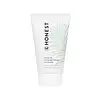What's inside
What's inside
 Key Ingredients
Key Ingredients

 Benefits
Benefits

 Concerns
Concerns

 Ingredients Side-by-side
Ingredients Side-by-side

Water
Skin ConditioningSodium Cocoyl Glycinate
CleansingCocamidopropyl Hydroxysultaine
CleansingCetyl Alcohol
EmollientGlyceryl Stearate Se
EmulsifyingIsoamyl Laurate
EmollientPropanediol
SolventCaprylic/Capric Triglyceride
MaskingSodium Chloride
MaskingPhytosterols
Skin ConditioningPhospholipids
Skin ConditioningHydrolyzed Sodium Hyaluronate
Skin ConditioningTrisodium Ethylenediamine Disuccinate
Sodium PCA
HumectantArginine
MaskingGlutamic Acid
HumectantXanthan Gum
EmulsifyingHydroxyacetophenone
AntioxidantLinoleic Acid
Cleansing1,2-Hexanediol
Skin ConditioningCaprylyl Glycol
EmollientCitric Acid
BufferingWater, Sodium Cocoyl Glycinate, Cocamidopropyl Hydroxysultaine, Cetyl Alcohol, Glyceryl Stearate Se, Isoamyl Laurate, Propanediol, Caprylic/Capric Triglyceride, Sodium Chloride, Phytosterols, Phospholipids, Hydrolyzed Sodium Hyaluronate, Trisodium Ethylenediamine Disuccinate, Sodium PCA, Arginine, Glutamic Acid, Xanthan Gum, Hydroxyacetophenone, Linoleic Acid, 1,2-Hexanediol, Caprylyl Glycol, Citric Acid
Water
Skin ConditioningCocamidopropyl Hydroxysultaine
CleansingBentonite
AbsorbentSulfur 3.3%
AntiseborrhoeicSodium Laurylglucosides Hydroxypropylsulfonate
CleansingGlycerin
HumectantDisodium Cocoyl Glutamate
CleansingSodium Chloride
MaskingSodium Cocoyl Isethionate
CleansingAcacia Senegal Gum
MaskingPyrus Malus Fruit Extract
Skin ConditioningCaprylyl Glycol
EmollientGlutamic Acid
HumectantMalic Acid
BufferingGlycolic Acid
BufferingLactic Acid
BufferingCoconut Acid
CleansingXanthan Gum
EmulsifyingSodium Cocoyl Glycinate
CleansingCaprylhydroxamic Acid
Trisodium Ethylenediamine Disuccinate
Quartz
AbrasiveCitric Acid
BufferingSodium Benzoate
MaskingWater, Cocamidopropyl Hydroxysultaine, Bentonite, Sulfur 3.3%, Sodium Laurylglucosides Hydroxypropylsulfonate, Glycerin, Disodium Cocoyl Glutamate, Sodium Chloride, Sodium Cocoyl Isethionate, Acacia Senegal Gum, Pyrus Malus Fruit Extract, Caprylyl Glycol, Glutamic Acid, Malic Acid, Glycolic Acid, Lactic Acid, Coconut Acid, Xanthan Gum, Sodium Cocoyl Glycinate, Caprylhydroxamic Acid, Trisodium Ethylenediamine Disuccinate, Quartz, Citric Acid, Sodium Benzoate
 Reviews
Reviews

Ingredients Explained
These ingredients are found in both products.
Ingredients higher up in an ingredient list are typically present in a larger amount.
Caprylyl Glycol is a humectant and emollient, meaning it attracts and preserves moisture.
It is a common ingredient in many products, especially those designed to hydrate skin. The primary benefits are retaining moisture, skin softening, and promoting a healthy skin barrier.
Though Caprylyl Glycol is an alcohol derived from fatty acids, it is not the kind that can dry out skin.
This ingredient is also used as a preservative to extend the life of products. It has slight antimicrobial properties.
Learn more about Caprylyl GlycolCitric Acid is an alpha hydroxy acid (AHA) naturally found in citrus fruits like oranges, lemons, and limes.
Like other AHAs, citric acid can exfoliate skin by breaking down the bonds that hold dead skin cells together. This helps reveal smoother and brighter skin underneath.
However, this exfoliating effect only happens at high concentrations (20%) which can be hard to find in cosmetic products.
Due to this, citric acid is usually included in small amounts as a pH adjuster. This helps keep products slightly more acidic and compatible with skin's natural pH.
In skincare formulas, citric acid can:
While it can provide some skin benefits, research shows lactic acid and glycolic acid are generally more effective and less irritating exfoliants.
Most citric acid used in skincare today is made by fermenting sugars (usually from molasses). This synthetic version is identical to the natural citrus form but easier to stabilize and use in formulations.
Read more about some other popular AHA's here:
Learn more about Citric AcidCocamidopropyl Hydroxysultaine is a synthetic cleansing agent, though it is derived from coconut oil.
It is used to enhance the texture of products by boosting lather and thickening the texture. As a cleanser, Cocamidopropyl Hydroxysultaine is mild.
Glutamic Acid is an amino acid that is found in all living organisms. Our bodies use this to help nerve cells in the brain communicate with other cells.
In cosmetics, glutamic acid is a famous humectant. It draws water from the air to your skin, keeping your skin hydrated (like hyaluronic acid).
An in-vitro study from 2024 found glutamic acid to play a role in inhibiting inflammation and thus a potential skin-soothing ingredient.
Other studies show it to be have potential wound healing, skin barrier repair, and hair growth properties.
Glutamic acid has poor solubility in water and other solvents.
Learn more about Glutamic AcidChances are, you eat sodium chloride every day. Sodium Chloride is also known as table salt.
This ingredient has many purposes in skincare: thickener, emulsifier, and exfoliator.
You'll most likely find this ingredient in cleansers where it is used to create a gel-like texture. As an emulsifier, it also prevents ingredients from separating.
There is much debate on whether this ingredient is comedogenic. The short answer - comedogenic ratings don't tell the whole story. Learn more about comegodenic ratings here.
The concensus about this ingredient causing acne seems to be divided. Research is needed to understand if this ingredient does cause acne.
Scrubs may use salt as the primary exfoliating ingredient.
Learn more about Sodium ChlorideSodium Cocoyl Glycinate is a cleansing agent. It can be naturally derived or synthetically-created.
As a surfactant, it helps clean your skin by gathering dirt, oil, and other pollutants to be rinsed away more easily.
Trisodium Ethylenediamine Disuccinate is used to help stabilize a product.
It is a chelating agent, meaning it helps prevent metal ions from binding to other ingredients. This prevents unwanted reactions in products. Metal ions can come into a product via the water ingredient. They are found in trace amounts and are not known to be harmful.
Water. It's the most common cosmetic ingredient of all. You'll usually see it at the top of ingredient lists, meaning that it makes up the largest part of the product.
So why is it so popular? Water most often acts as a solvent - this means that it helps dissolve other ingredients into the formulation.
You'll also recognize water as that liquid we all need to stay alive. If you see this, drink a glass of water. Stay hydrated!
Learn more about WaterXanthan gum is used as a stabilizer and thickener within cosmetic products. It helps give products a sticky, thick feeling - preventing them from being too runny.
On the technical side of things, xanthan gum is a polysaccharide - a combination consisting of multiple sugar molecules bonded together.
Xanthan gum is a pretty common and great ingredient. It is a natural, non-toxic, non-irritating ingredient that is also commonly used in food products.
Learn more about Xanthan Gum